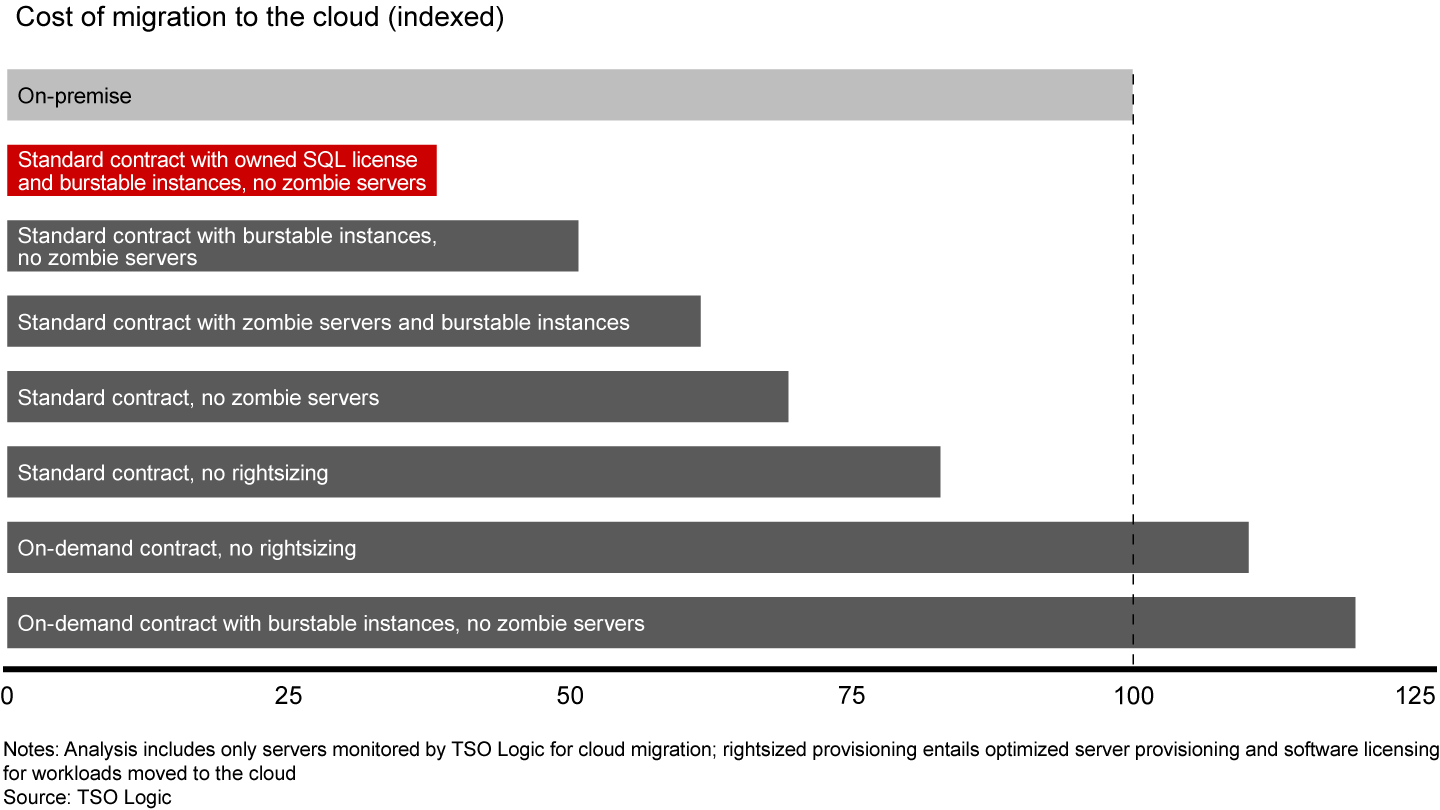記事
 }
}
This is the sixth in a series of posts on the enterprise cloud market—its economics, customer segments and the opportunities for technology providers.
Executives are often disappointed when they migrate their workloads to the public cloud because the efficiencies and savings that they have been promised fail to materialize. In fact, Bain surveyed more than 350 IT decision makers about their cloud migration and found that their top complaint was that costs had not gone down.
In some cases, costs can actually go up: When companies don’t do the necessary preparatory work, direct-match migration to the public cloud can be 10% to 15% more expensive than keeping the work in an on-premise environment. In other words, for all the promise of the cloud, sometimes it can be cheaper to keep things as they are.
This is because most existing workloads are overprovisioned, meaning that when companies migrate a workload to the cloud, they’re sending excess computing and storage capacity right along with it. Instead of becoming more efficient, they’re just transferring their existing inefficiencies to a new location—a practice known as “lift and shift.”
When companies send their workload to the cloud, most send excess capacity along with it
- 84% of on-premise workloads are overprovisioned.
- 16% are rightsized.
Companies are much more likely to see real savings when they view migration as an opportunity to rationalize their computing and storage practices. Going through this process often reveals a great deal of fragmentation and duplication, with workloads scattered across machines and data centers. Records can be incomplete and outdated. Some companies even discover “zombie servers”—that is, computers that are no longer needed that have never been deactivated.
However, they can cut costs by as much as 30% to 60% if they rethink their workloads when they migrate them to the public cloud (see Figure 1).

Even companies without transferable licenses can generate considerable savings by rightsizing their workloads. That means eliminating zombie servers, winding down unnecessary activities and accurately provisioning all the work that is migrated. Many companies find that they can provision their workloads more tightly if they set up a reserve of excess capacity that they can draw on when needed for surges in activity.
Following a straightforward, structured process will help manage this optimization:
- Assess usage patterns.
- Study the intensity and duration of average peak computing demand so that you can make informed decisions about downsizing server capacity and accommodating excess demand.
- Identify storage patterns, evaluating average and peak usage and proximity to the server.
- Rationalize the number of core processors so that you can reduce spending on software licensing fees that are tied to processor counts.
IT leaders should also prioritize workloads that would benefit the most from migration. Migrating nonproduction workloads to the public cloud can deliver more savings than migrating production workloads can, mainly because the computing usage in nonproduction workloads tends to be more volatile and would likely benefit more from the flexibility that the cloud provides. Similarly, nonvirtualized workloads can benefit more from migration than virtualized workloads can, since virtualized workloads already benefit from improved utilization and flexibility.
This type of planning can make a dramatic difference in cost. TSO Logic, a subsidiary of Amazon Web Services, found that a company with 105,000 server instances and 20 terabytes of storage on-premise would have increased its costs by 22% with direct-match migration, but it could reduce costs by 36% by rightsizing its workloads.
These findings indicate significant opportunities for cloud technology vendors if they can find ways to help their customers plan their migration, optimize their workloads, and manage hybrid environments with a mix of cloud and on-premise technologies.
Migration to the public cloud doesn't have to be disappointing. The public cloud offers serious benefits to companies trying to keep pace with digital innovation. It’s easy to use and can be scaled on demand, it’s reliable and features continuous uptime, and companies don’t have to spend a penny on maintenance. When companies rightsize their workloads, they can reap all these benefits of the public cloud and actually save money in the process.
Mark Brinda and Kate Woolley are partners with Bain & Company’s Technology practice; both are based in New York.

Mastering the Cloud Economy
Technology providers selling cloud software, services and hardware can strengthen their value proposition by developing a better understanding of cloud economics, customer preferences, and the impact of the cloud’s ascendance in legacy and disruptive technologies.
